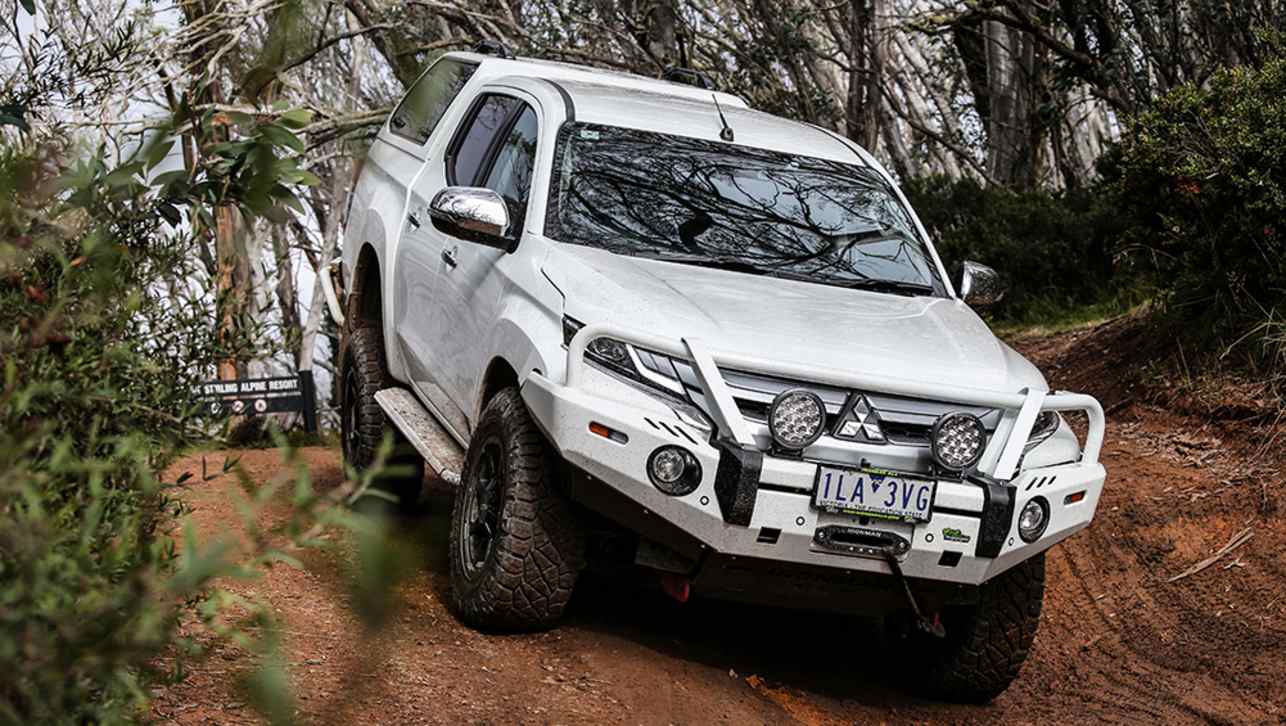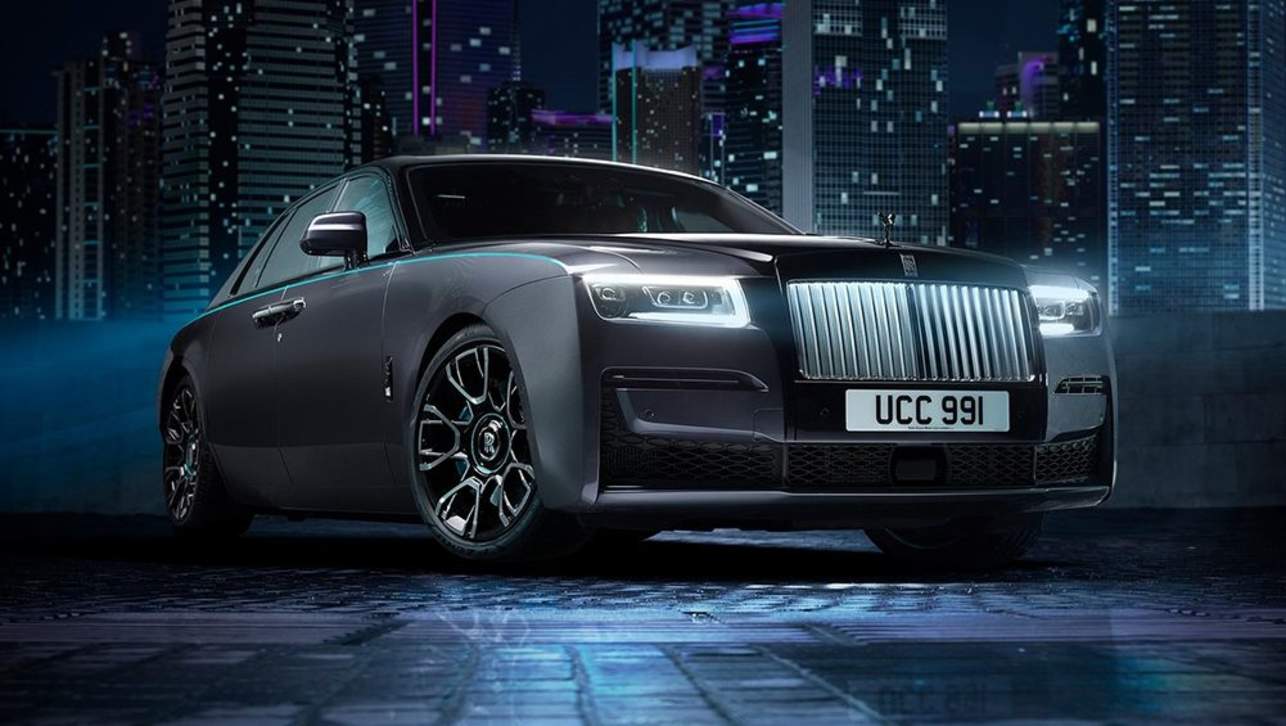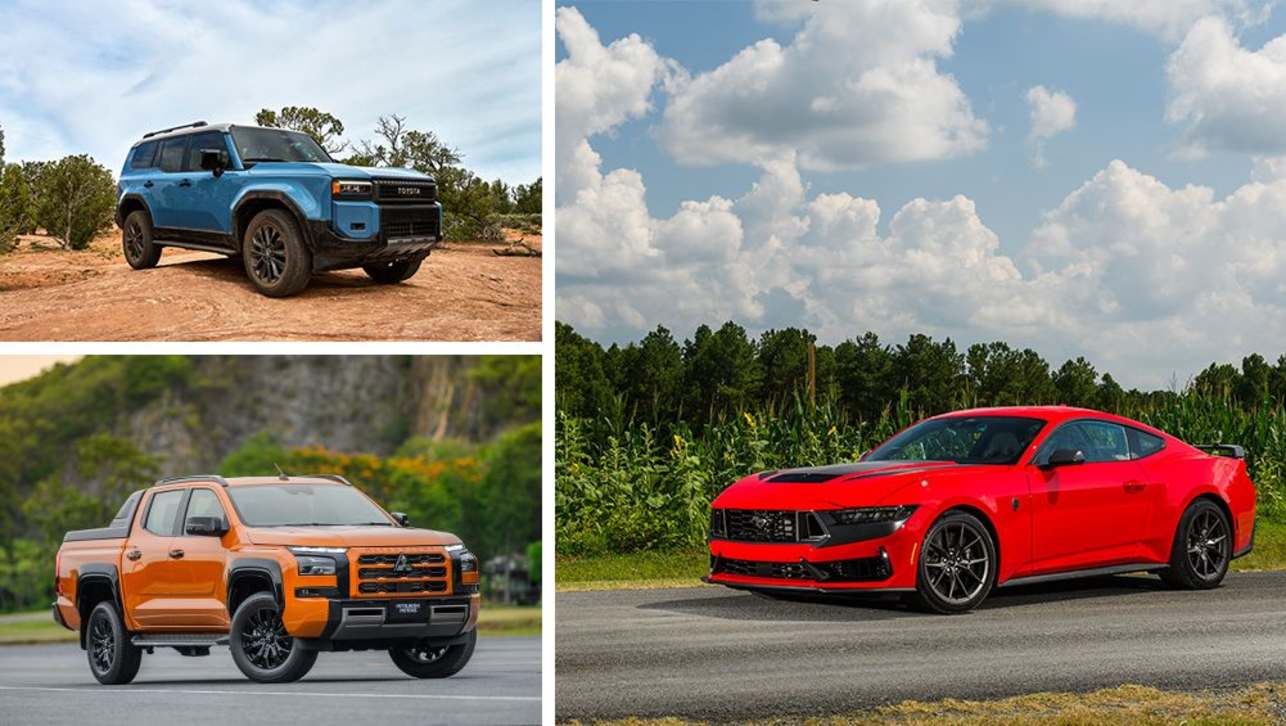The Mitsubishi Triton has never commanded the sales success or worksite grandeur of single- and dual-cab utes, such as the Toyota HiLux or Ford Ranger. But it's place as arguably the best-value new ute on the market has ensured its popularity and that a wide range of aftermarket accessories are available for it.
That means if you need to deck out a Triton with a bull bar, off-road tyres, canopy and roof-rack for off-road adventure, you can. If you need to get custom toolboxes, ladder racks and a personalised tray, that's easy too.
For a comprehensive guide to Mitsubishi Triton aftermarket accessories for work or play, read on.
Mitsubishi Triton Suspension Lift
.jpg)
Overview: One of the most useful modifications to get more off-road performance, or load carrying ability is to fit a specific lift kit for Mitsubishi Tritons. Most aftermarket suppliers recommend a modest suspension lift of around 25 to 40mm upfront and 20 - 40mm at the rear so undue stress isn't being placed on mechanical components. Most lift kits will also include options to increase the spring rates of the rear leaf springs, to help improve the ride when carrying a load.
It's essential to consider the loads when choosing a new suspension system for your 4WD. A lot of experts often recommend it be one of the last modifications you make so that you can take into account the added weights of accessories like bullbars, winches, roof racks, storage systems or custom tradie trays.
Where to Buy: All of the major aftermarket fitters like ARB, Ironman 4x4, TJM and Opposite Lock supply and fit kits in Australia.
Cost: A full suspension lift for a Mitsubishi Triton will cost anywhere from $1300 to $2500, plus the cost of fitment.
Mitsubishi Triton Bull Bar
.jpg)
Overview: In a country as vast and unfenced as Australia, anyone planning overland travel in a 4WD should consider a bulbar to reduce the chance of an animal strike prematurely ending a trip. But, not only that, a bull bar on your Triton opens up options for recovery gear like winches, additional lighting and secure places for communications aerials (we motoring journos used to say for things like UHF radios, but 4G or WiFi extenders are becoming more relevant).
A good Mitsubishi Triton bull bar adds protection to the front end but doesn't compromise integral safety systems like airbags, or in the case of the MN Triton, autonomous braking. It also shouldn't be so heavy that the front axle weights are overloaded. When buying, consider whether what you'll need to fit to the bar down the track, and shop accordingly.
Where to buy: Mitsubishi Triton genuine accessories includes a range of bullbars factory-approved which can be purchased new with the vehicle or fitted down the track. Available in powder-coated black or polished aluminium, they can be equipped with or without fog lights and are compatible with the vehicle's autonomous braking system. Lights and some accessories can be fitted, but they're not winch compatible.
Aftermarket suppliers like Ironman 4x4 offer a lot more variety, like the option to have not hoop or top bar, steel options, and bars that are winch compatible. Fitting usually involves cutting or drilling new holes into the $40,000 ute you just bought, so is often best left to a professional who offers a warranty.
Cost: The genuine Mitsubishi Triton bull bar starts at $3461 without fog lights or $4193 with.
Mitsubishi Triton Tow Bar
.jpg)
Overview: The Triton can tow a respectable 3100kg and cope with 310kg of ball weight, making it an excellent choice towing a caravan or camper trailer. Although a lot of people choose the Mitsubishi Triton for towing duties, it's not a standard feature, so you'll have to tick the box when ordering, or have one fitted aftermarket. We suggest asking for a 12-pin flat plug wired conventionally, as it's the most versatile connector to nearly any modern trailer. If towing a heavy caravan, consider using a weight-distribution hitch to improve braking and steering performance with the van on the back. Towing mirrors are also essential if the width of the trailer compromises rear-vision. Avoid the type which clips onto the mirror, as passing trucks will blow the mirrors into the window every time.
Where to buy: The best tow bar will be the one from Mitsubishi, which was developed in line with the vehicles engineered capabilities. In Australia, Hayman Reese is the best-regarded aftermarket supplier of tow bar kits for nearly any vehicle. Specifically, the company's off-road, high-clearance, heavy-duty X-Bars are an excellent option for serious off-road tourers.
Cost: The factory fitted tow bar from Mitsubishi costs between $1162 and 1170, depending on the variant. From Hayman Reese, the X-Bar can be got for around $1200, plus fitting.
Mitsubishi Triton nudge bar
.jpg)
Overview: Although these offer less protection from large impacts, the humble nudge bar is an inexpensive insurance policy against smaller knocks, especially in metro areas where parking is a pain. They're also great if you do want to fit some extra driving lights (a lot which now come with a daytime running light feature) to the front without the weight and expense of a full bull bar.
Where to buy: Mitsubishi's genuine accessories includes two aluminium nudge bars in a polished finish or black powder-coated. They can be optioned up with an authentic Mitsubishi Triton light bar. And they look more stylish than the chrome hoops we'd typically associate with nudge bars.
Cost: You can add a nudge bar to your Triton for $1126. The light bar is another $708 fitted.
Mitsubishi Triton Canopy
.jpg)
Overview: Although ute trays are great for lugging gear around, they're not immediately great at keeping that gear secure, dry or dust-free. There is a massive range of options when it comes to enclosing the Triton's tray or tub, (be that dual cab or single cab trays) to suit everything from the busy tradie to the adventurous off-road tourer. What you'll find best for you will depend on what sort of access you need to the back, if there's other storage solutions integrated, and if you'll be adding additional accessories onto the roof of the canopy.
The most straightforward solution is the genuine Mitsubishi Triton soft tonneau cover. Still, there are also genuine fibreglass, roller and alloy checker plate versions which can be fitted with optional roof-rack rails, great for sitting bikes on top of. The genuine canopies are supplied by EGR, an Aussie company that manufactures in Brisbane. Choose from sliding, lifting or sliding/lifting window options and integrated central locking. Most people prefer the lifting windows for ease of access, but sliding windows are popular with owners who have dogs and need to keep ventilation while driving.
If a canopy is a must-have, there's a few features which are well worth the extra money you'll have to pay for a premium version. These include keyless entry, interior lights, access to 12V circuitry to help run camping conveniences or a fridge, an anti-entrapment dial, so you don't get stuck in there, and enough strength to carry a load on the roof – like a rooftop tent or a stack of ladders. And remember, the weight of a canopy sucks up load capacity, so the lighter, the better, without sacrificing strength. Alternatively, no shortage of bespoke manufacturers can fabricate the perfect camping or tradie custom trays
Where to buy: Get yours directly from Mitsubishi, or EGR, which is the MMAL approved supplier of canopies. Other top-quality versions are available companies like Ironman 4x4, ARB, Norweld, Carryboy, Flexiglass, Opposite Lock, TJM, amongst others.
Cost: A soft tonneau cover will set you back at least $753 from Mitsubishi, while the genuine canopies begin at $3927. For an aftermarket canopy, budget from $2500 and up, depending on features, materials and brand.
Mitsubishi Triton Drawers
.jpg)
Overview: In such a large load area, drawers help keep things organised and easy to access, even when the whole space is full. Perfect for camping or worksites, a good drawer system can carry a lot of weight, is easy to open and close and doesn't waste space. Side-by-side drawers are great if you carry bulky items on top and need the space, while stacked drawers are great if you have a fridge, and don't want it so high on the tray you can't see in it.
Where to buy: Although all the major 4WD outfitters supply drawers for companies like OffRoad Systems and Drifta Camping Camping & 4WD custom make two of the best drawer systems on the market.
Cost: A dual drawer system for a dual-cab tub tray from Drifta begins at $1845, but can be customised to your heart's content. From ORS, a 1030mm long twin drawer system starts at $1800, plus $150 for fitting. Neither fit with a Mitsubishi Triton Tub Liner or Mitsubishi Triton sports bar so don't tick that option if drawers are on your wish-list.
Mitsubishi Triton roof racks
.jpg)
Overview: The last two Triton variants have been able to carry a roof load of 100kg. However, many tray back canopies are designed to carry even more than that, making roof storage a versatile option (but remember, load up high increases vehicle instability, so keep it light as possible). There is an endless range of roof racks and roof rails and accessories for the Triton with everything from ladder racks, mounts for spotlights, (check your local rules on roof-mounted spotties, though), bikes, boards, boats and tents.
Where To Buy: Thule is the Mitsubishi approved supplier of racks for the Triton, and almost all variations and accessories can be ordered with a new vehicle. Alternatively, Rhino-Rack is the premium brand in Australia, supplying roof racks.
Cost: Thule roof rack cross bars cost $540 fitted to a new Mitsubishi. You can order similar products from Rhino Rack and fit them yourself from $432.
Mitsubishi Triton snorkel
.jpg)
Overview: Essential if you do any sort of off-road touring that involves long stretches of dusty roads or the possibility of deep water crossings, a snorkel raises the air-intake position to roof height so that the engine is less likely to suck in dirty air or water. Plus, you get to hear the cool turbo spool noise as you accelerate or change gears.
Where to buy: Mitsubishi doesn't offer a factory-fitted snorkel, so you'll have to turn to the aftermarket for one. The best name in the industry is Safari 4x4, which make snorkels for almost every model 4WD on the market. Fitting involves cutting a big hole in the front panel, so if you're not comfortable with that level of surgery, get a pro to fit it.
Cost: Expect to pay around $450 for the kit, plus fitting.
Mitsubishi Triton wheels, rims and tyres
.jpg)
Overview: The current Triton 4WD variants are nearly all fitted with 245/70R16 all-terrain tyres on 16x7.0J alloy rims, although the top-spec GLS gets 265/60R18 highway terrain rubber on 18x7.5J alloy rims. The 18in tyres have an inch larger rolling diameter (29.5in vs 30.5in). To keep within the 50mm limit on tyre diameter increases, a 285/60 R18 (31.5in) tyre is the biggest you can fit to the Triton, although a suspension lift might be needed to keep the clearance.
Where to buy: Get the best deals on tyres from one of the tyre comparison websites like Tyroola.
Cost: A decent set of all terrains will cost anywhere from $250 to $500 a tyre in 285/60 R18 size.
Mitsubishi Triton seat covers
.jpg)
If you have kids, dogs or just hate mess in creases, get some seat covers.
Overview: If you're an active person or just have kids, seat covers will be invaluable, especially when it comes time to sell the car and you need to make sure the Triton looks its best.
Where To Buy: Mitsubishi can supply neoprene seat covers for the front and back seats, and are airbag compatible. They have no tie-down straps, so they're easy to remove to clean.
Cost: The front set costs $532 and the rear costs $567.
Mitsubishi Triton side steps
.jpg)
Overview: In high-riding vehicles, side steps make getting in and out that much easier. They're also great if you regularly use roof racks and need a step up to help tie things down. Side-steps shouldn't be confused with rock-sliders or side-rails, though, which are designed to offer protection against damage while 4WDing. They'll have been superficially engineered to prevent damage when traversing rough terrain, and are a great addition to underbody protection bash plates.
Where to Buy: Genuine side steps are available directly from Mitsubishi. Aftermarket versions can be got from most 4WD outfitters including ARB, TJM, Ironman 4x4 and Opposite Lock.
Cost: Genuine side steps will add $1161 to the price of your new Triton.
Mitsubishi Triton dual battery system
.jpg)
Overview: If you run any sort of auxiliary 12-volt accessories, a dual battery is a must so that you can protect the charge that's in your starting battery. The simplest systems use a solenoid to isolate each battery from the other, but the best systems today at DC-DC chargers, which often provide three or more stages of charge to the second battery, keeping it in tip-top condition, and are compatible with modern smart alternators. I wouldn't bother with anything less. A second battery is best kept close to the accessories it's charging, assuming it's safe to do so (in the tray, near the fridge). If it must go under the bonnet, you're restricted to an N50 size battery in the diesel, or an N70 if you have a petrol version. That's not enough, and they don't like the heat.
Where to buy: The two best DC-DC battery chargers on the market come from Redarc and Projecta. Both will charge a battery to 100 per cent, can accept charge from solar panels, and are easy to use.
Cost: The Redarc BC-DC25 starts at $609.10. The Projecta IDC25 retails for around $300.
Mitsubishi Triton navigation system
.jpg)
Overview: Although the current crop of Triton variants are fitted with phone mirroring displays which include Google or Apple Map functionality, these have their limits if there's no mobile service. For the best off-road mapping solutions, it's hard to go past the Hema Navigator which is a standalone unit, or the Hema Explorer app that'll work as long as you have GPS reception.
Where to buy: You can pick up a Navigator from most 4WD or camping outlets, or download the app from your app store of choice.
Cost: BCF sells the HX-1 Navigator for $549. Hema Explorer cost $49.99 from an app store, and there are in-app upgrades and purchase for more content.



.jpg)
.jpg)

.jpg)
 copy.jpg)




.jpg)
.jpg)


.jpg)



.jpg)
.jpg)
.jpg)






Comments